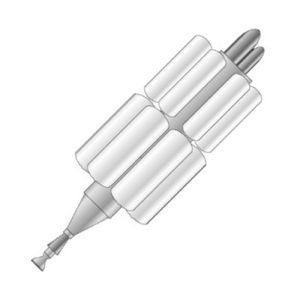
Home - Search - Browse - Alphabetic Index: 0- 1- 2- 3- 4- 5- 6- 7- 8- 9
A- B- C- D- E- F- G- H- I- J- K- L- M- N- O- P- Q- R- S- T- U- V- W- X- Y- Z
Mars Expedition NASA Lewis 1960
 Mars NASA Lewis 1960 Faget Mars Expedition Credit: © Mark Wade |
Status: Study 1960. Gross mass: 614,000 kg (1,353,000 lb).
Radiation protection of the crew was a major concern.
In 1960 NASA's Lewis Research Center conducted the first NASA studies of the spacecraft and equipment required for a manned expedition to Mars. A standard mission profile was established. This basically followed the Von Braun scheme of 1952. A spacecraft would be assembled in low earth orbit, and then launch itself toward Mars. After using rockets to brake into Mars orbit, a separate lander would descend from a mother ship to the surface. After exploration of the terrain it would launch itself back into Mars orbit to rendezvous and dock with the mother ship. A rocket would boost the mother ship back toward earth. The scheme differed from Von Braun's in having seven crew and using nuclear thermal propulsion, which in turn allowed a faster 420 day opposition-class mission with 40 days on Mars. Instead of using rockets to brake into earth orbit on return, an earth return vehicle would separate from the mother ship. This was seen as a 13.6 metric ton delta-wing spaceplane with a 6.7 m wingspan, which would re-enter the earth's atmosphere. The mother ship would be disposed of, sailing past earth into solar orbit. Launch date would be 19 May 1971, and total mission delta-V would be 19.8 km/s.
The danger of radiation outside the earth's protecting radiation belts was understood now, and Lewis considered provision of an appropriate radiation shelter a major driver in any expedition design. The mother ship habitation quarters provided 35 square meters of floor space on two levels, with a cylindrical radiation vault at the centerline, which doubled as sleeping quarters. Such a shelter would weigh 21.4 metric tons if a maximum exposure of 100 REM was considered permissible and no major solar flares occurred. However if the crew exposure had to be limited to 100 REM and it was assumed one flare would occur, the shelter's mass would increase to 74.5 metric tons. If crew exposure was limited to 50 REM, the mass of the shelter shot up to 127 metric tons. Lewis found that shorter duration trips were no heavier than longer trips to Mars, since the shelter would be lighter on a shorter trip for the same radiation dose. All things considered, the final Lewis conclusion that a ship using nuclear thermal propulsion, meeting the mission profile, and limiting the crewmember's dose to 100 REM, would have a total mass of 614 metric tons on departure from earth orbit.
Mars Expedition NASA Lewis 1960 Mission Summary:
- Summary: First NASA Mars expedition design; first to propose use of nuclear thermal propulsion
- Propulsion: Nuclear thermal
- Braking at Mars: propulsive
- Mission Type: opposition
- Split or All-Up: all up
- ISRU: no ISRU
- Launch Year: 1971
- Crew: 6
- Mars Surface payload-metric tons: 40
- Outbound time-days: 150
- Mars Stay Time-days: 40
- Return Time-days: 240
- Total Mission Time-days: 420
- Total Payload Required in Low Earth Orbit-metric tons: 614
- Mass per crew-metric tons: 102
- Launch Vehicle Payload to LEO-metric tons: 100
- Number of Launches Required to Assemble Payload in Low Earth Orbit: 7
- Launch Vehicle: Saturn V
Crew Size: 7.
Family: Mars Expeditions. Country: USA. Propellants: Nuclear/LH2. Agency: NASA Cleveland. Bibliography: 591.
Back to top of page
Home - Search - Browse - Alphabetic Index: 0- 1- 2- 3- 4- 5- 6- 7- 8- 9
A- B- C- D- E- F- G- H- I- J- K- L- M- N- O- P- Q- R- S- T- U- V- W- X- Y- Z
© 1997-2019 Mark Wade - Contact
© / Conditions for Use